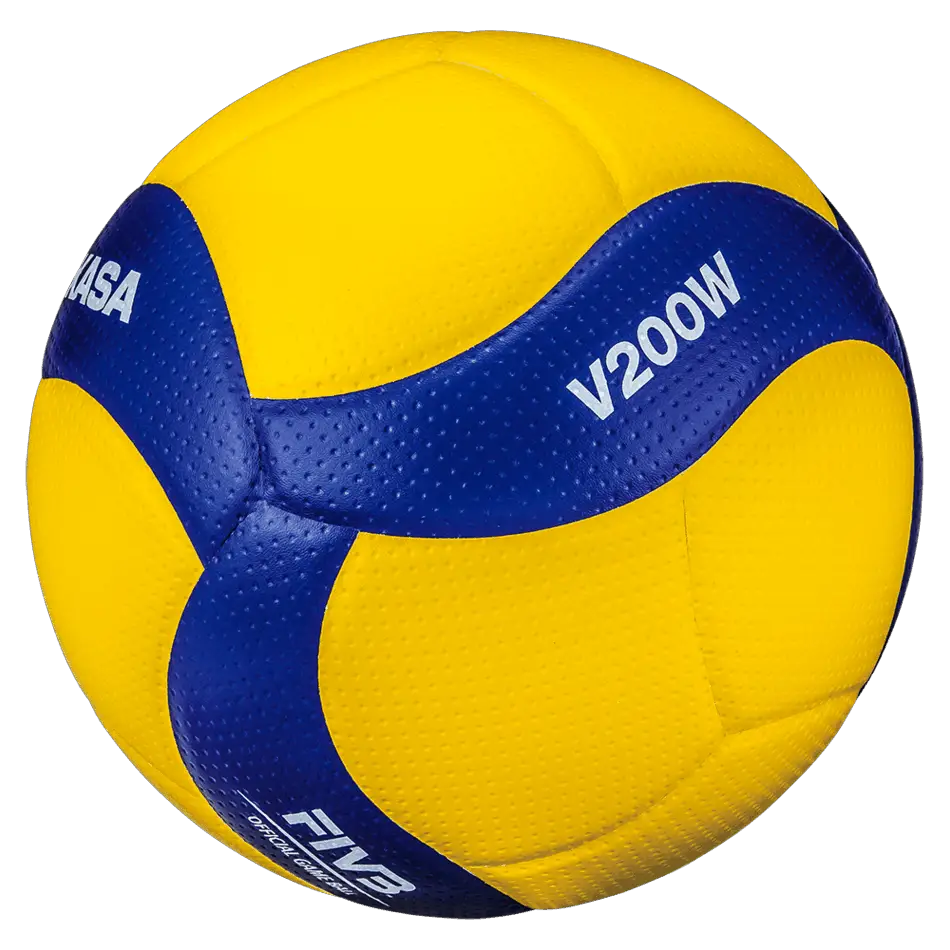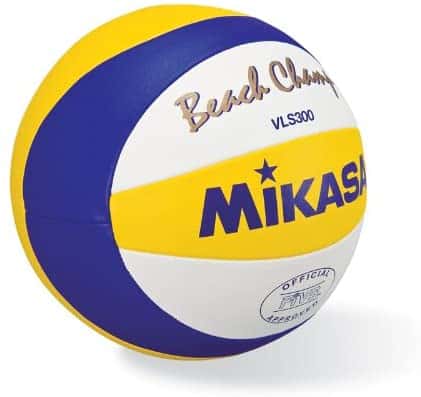It is believed that Volleyball is one of the 10 most popular sports in the world. With over 900 million estimated fans and a long history, it was inevitable for volleyball to develop many variations. The game has evolved in numerous ways since its conception. Sometimes players adapted new rules, new strategies, and sometimes they just reinvented the game itself by coming up with new ways to play. Regardless of how we got here, human creativity came up with many different versions of this great sport.
In order of popularity across the world, the 5 most popular volleyball variations are :
- Indoor Volleyball
- Beach Volleyball
- Kick Volleyball (Sepak Takraw)
- Footvolley
- Snow Volleyball
This list will take us around the world where we will find the ingenuity behind all these variations.
1. Indoor Volleyball
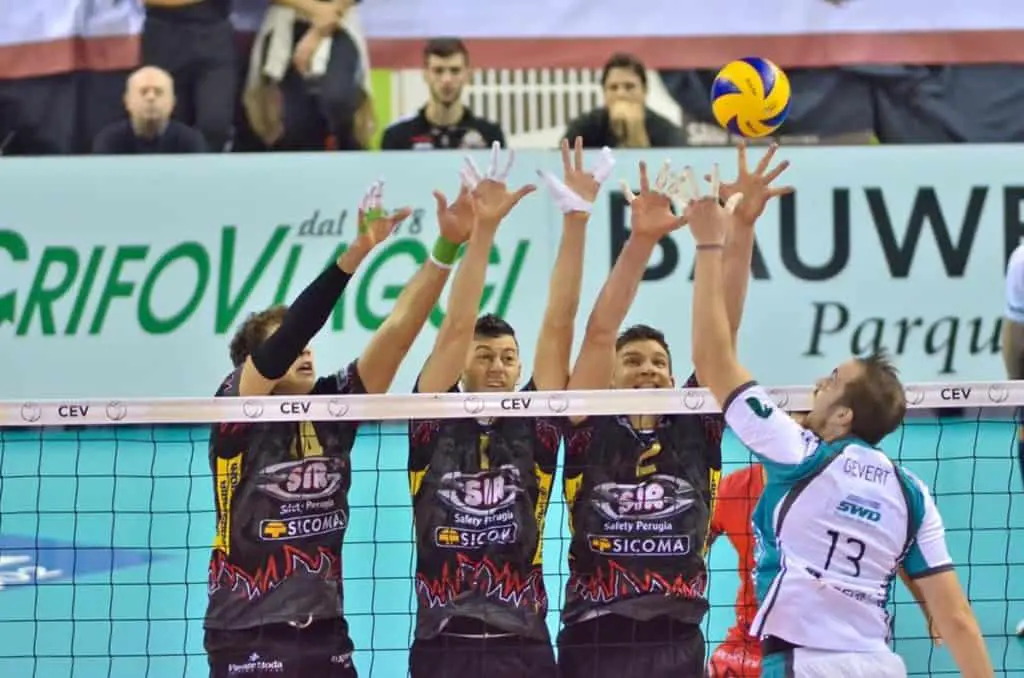
Overview
The classic form of volleyball that we know and love today is commonly referred to as indoor volleyball. The sport is said to have been invented in 1895 by William G. Morgan, a YMCA physical director of Holyoke, Massachusetts.
This traditional form of volleyball is played in gymnasiums, on a large court with a net in the middle. The game is played in rallies where two teams compete for a point. The first team to win 25 points/rallies wins the set. A rally starts with a team serving the ball to the opposing team. To score a point players will attempt to make the ball land on their opponent’s side of the court. They are allowed to use all parts of their body to make contact with the ball, although players will mainly use their hands. Rules also clearly indicate that they are not allowed to hold the ball in any way. Teams are allowed a maximum of three contacts before the ball must be returned on the opposing side of the net.
For more regarding the rules of volleyball, click here to read the official rules of the Fédération Internationale de Volleyball (FIVB).
| Court Size | 59 feet (18.29 meters) long by 29.5 feet (9 meters) wide. |
| Number of players | Teams must have 6 players on the court during play. |
| Net Height | Men’s: The net is 2.43 m (7 ft 11 in) Women’s: The net is 2.24 m (7 ft 4 in). |
The Ball
Depending on the age, gender, and skill level, the characteristics of the volleyball can change. Generally, players will use an air-filled ball with a circumference of 25.5-26.5 inches and an inside pressure of 4.26-4.61 psi. The ball weighs between 9.2 and 9.9 ounces. See the image below for an example of an indoor volleyball. This Mikasa V200W volleyball is currently the official game ball of the FIVB that will be used in the 2020 (now 2021) Tokyo Olympics.
Competition
Being the original format of the sport, indoor volleyball has the widest range of competitions from any form of volleyball. There are many levels of play where athletes can compete. These include schools, clubs, colleges, and extends to professional volleyball, and international championships. Volleyball has also been part of the Summer Olympic Games since the 1964 Tokyo Olympic Games.
Popularity
Indoor volleyball is the number one on this list for the simple reason that it is the original and most widespread iteration of the sport. The largest international sports governing body in the world, the FIVB, includes 221 member Federations. They estimate that there are over 800 million athletes playing volleyball worldwide. The FIVB is in charge of organizing international championships, adopting and improving rules of play, and instructing and certifying referees and coaches. They also lead the way in the general promotion of the game around the world.
2. Beach Volleyball
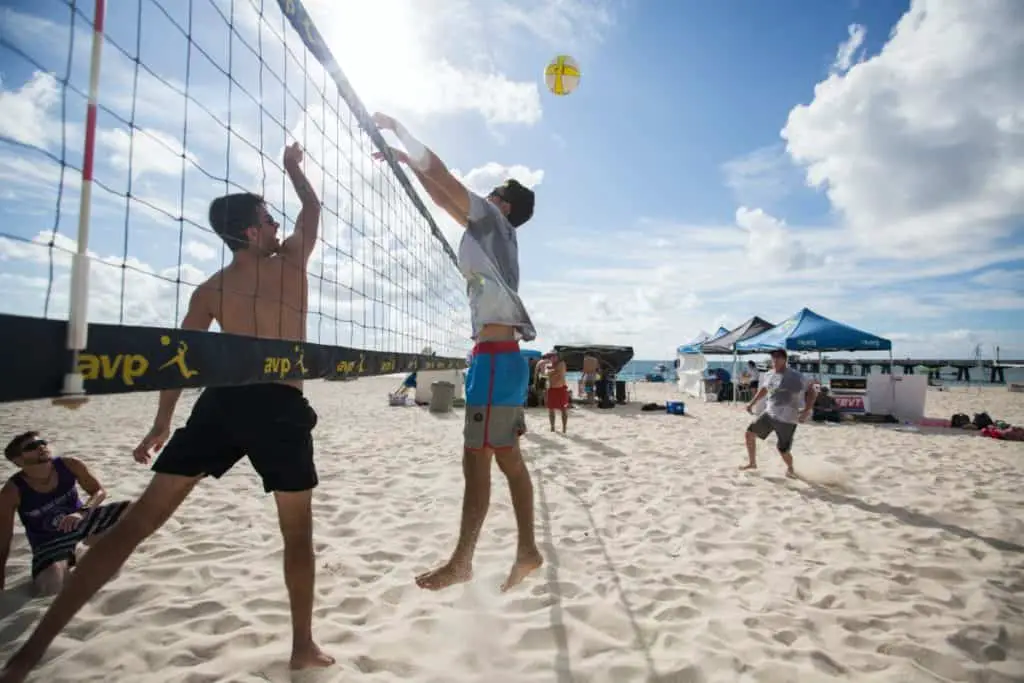
Overview
Beach volleyball is without a doubt the most popular volleyball variant. It is believed that it originated in Hawaii around the year 1915. As the name indicates, beach volleyball adapted the game of volleyball to sandy beaches instead of indoors. Just like indoor volleyball, this variation opposes two teams on a court with the goal of making the ball land on the opposing side of the court. While the variant does make some adjustments, the core of the mechanics and gameplay remain clearly tied to the original volleyball format.
Variations and Differences
Along with some rule changes, the game also has a different court size, number of players, and type of ball used. Furthermore, beach volleyball has the added factor of the outdoors. The weather can drastically influence the gameplay. Rain, wind, and sunshine can all affect the game.
Here are some other key differences:
- The number of points needed to win changes from 25 to 21.
- Open-hand tips or dinks are not allowed.
- Unlike indoor volleyball, the block touch will count towards the 3 touches allowed.
- There are no assigned positions to each player.
- In the name of fairness and impact from the weather, beach volleyball teams switch sides on the court every seven points. This practice ensures that no team has an advantage due to environmental factors such as the wind or sun glare.
- The court is made using only sand.
| Court Size | 52.5 feet (16 meters) long by 26.2 feet (8 meters) wide. |
| Number of players | 2 players per team. |
| Net Height | Men’s: The net is 2.43 m (7 ft 11 in) Women’s: The net is 2.24 m (7 ft 4 in). |
The Ball
The ball used for beach volleyball closely resembles the original. The key change is the material, which is more flexible and also water-resistant. It is also slightly larger than indoor balls, has a rougher external texture, and lower internal pressure. All these changes make the ball better suited for outdoor conditions. See the image below for an example of the FIVB beach volleyball used official beach volleyball competitions.
Competition
At the lower levels, beach volleyball courts can be found on many beaches of South and North America, where anyone can play recreationally. Climbing up in skill levels, we can find that some clubs and schools will offer programs in beach volleyball. The NCAA also includes beach volleyball as a competitive sport. More than 90 colleges across all divisions offer a program, and this number is growing every year.
Beach volleyball has many competition levels and just like volleyball, it is also part of the summer Olympics. It’s in 1996, during the Atlanta Olympic games that beach volleyball made its official debut as a discipline for both men and women.
Finally, just like for indoor volleyball, the FIVB remains the largest authority in beach volleyball and also oversees the highest level of competition.
Popularity
Much like indoor volleyball, beach volleyball has large recognition across the globe. More specifically, beach volleyball has an immense presence in South America, North America, Europe, and Oceania. In 2016, over 169 nations competed for a chance to qualify for the Rio Olympic’s beach volleyball. With the popularity of the game and social media, the game seems to be growing considerably every year.
I’ve scoured the internet, trying to find hard numbers about the popularity of beach volleyball, but to no avail. What I can say is that the viewership of videos on beach volleyball on Youtube is considerably lower for beach volleyball in comparison to indoor volleyball. For example, the 2019 volleyball world finals of the Volleyball Nations League garnered more than 2.4 million views on Youtube. In comparison, the Beach Volleyball World Tour Finals Rome 2019 received around 200k views. This simply demonstrates that the popularity of this variation is not as considerable compared to indoor volleyball.
At the end of the day, many of the differences between the two variations make beach volleyball a much more accessible version of the sport. As we know, beach volleyball requires little to no equipment, fewer players, a net, and a ball, that is it. Go to the nearest beach and get playing.
3. Sepak Takraw
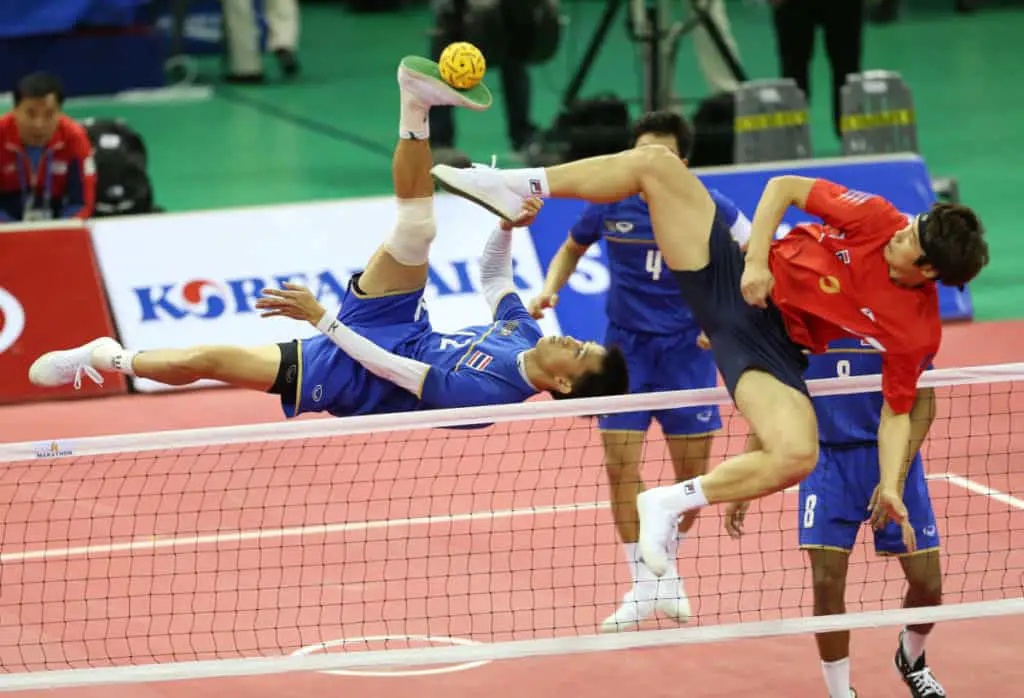
Overview
In third place, we have our first real dramatic shift from traditional volleyball with Sepak Takraw. This game originally from Southeast Asia has no clear connection to volleyball and in fact, could have been created well before the 1900s. Takraw is a word in Thai meaning woven rattan ball and Sepak refers to the word for kick. Sepak Takraw can be quite literally translated to “to kick a ball”. Nowadays, you will often see that this game gets the nickname “Kick Volley”.
Like other forms of volleyball games, Sepak Takraw is played in a rectangular court, with a net in the middle, and the point is made by using the rally scoring method. A rally starts when a team kicks the ball to their opponent’s side of the court, just like a service in volleyball. And again, just like all forms of volleyball, the goal is to make the ball land inside the lines of the opposing side of the court. Teams still only have 3 touches before they must send the ball over the net.
Variations and Differences
Sepak Takraw is a big departure from the classic version of volleyball mainly because of the method used to contact the ball. Here are some of the other major gameplay and rule changes:
- The ball cannot be touched with the hands. Players use their feet, knee, chest, and head to make contact with the ball.
- A team needs 25 points to win a set. The first team to win 2 sets, wins the game. In the event of a third and final set, only 11 points are needed to win the set.
- For the service, the ball is thrown to the server by a teammate which then must be kicked over the net whilst keeping at least one foot in the service circle.
- The “Tekong” or server, is responsible for serving/kicking the ball to initiate the rally. There is only one Tekong on the team.
- Other than the Tekong, there are no official positions enforced, although generally, a team will have a “Killer” (spiker) and a “Feeder” (setter).
- Players are allowed more than one contact with the ball in a row. In other forms of volleyball that would be considered a fault.
- There are two formats to the game. “Regu” is a 3v3 and “Double Regu” is a 2v2.
- The court can be indoor or outdoors but has to be on a solid surface.
| Court Size | 44 feet (13.4 meters) long by 20 feet (6.1 meters) wide. |
| Number of Players | Regu: 3 players per team. Double Regu: 2 players per team. |
| Net Height | The net is 5 feet high, just like a badminton net. |
Reading all these changes might still be confusing for someone who has never seen a game of Sepak Takraw. So if you are curious, I encourage you to have a look at the video below.
You can also read more about the rules of Sepak Takraw here.
The Ball
The ball used for Sepak Takraw is spherical and made of synthetic fiber or a woven layer. The original ball used was a rattan ball until access to newer technologies and materials initiated a transition to hard synthetic fiber and rubberized plastic.
Rules dictate that the ball must have 12 holes and 20 intersections. The circumference should be between 16.14 inches (0.41m) and 17.3 inches (0.44m). The ball should weigh between 170g (grams) to 180g for men and
from 150g to 160g for women.
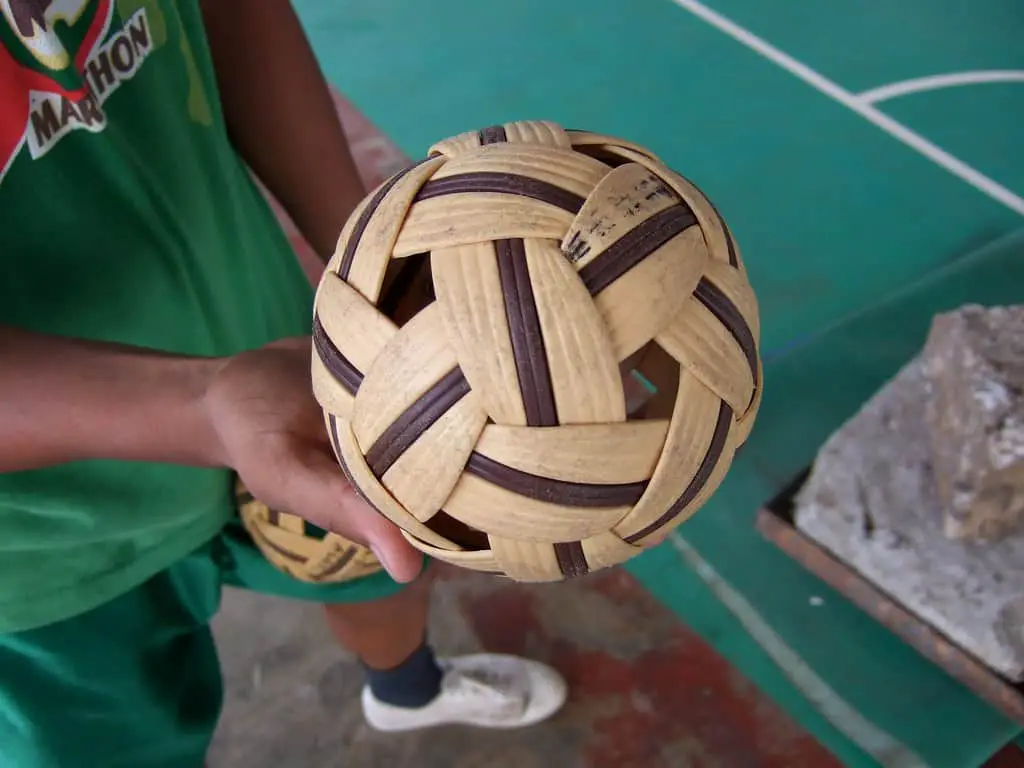
Competition
Much like indoor volleyball, this game has a lot of competition levels. At the top, there is the King’s Cup Sepaktakraw World Championship, the biggest event in Sepak Takraw.
In 1965, the Asian Sepaktakraw Federation (ASTAF) was formed to govern the sport in Asia and it’s in 1992 that the International Sepaktakraw Federation (ISTAF) was formed as the world governing body for the sport. Here is a link to their website for those who are curious.
Because the game is so ingrained in Southeast Asian countries, you will not find many western teams qualifying for this event. In fact, Thailand, Vietnam, Malaysia, Indonesia, and others in the region are examples of the nations you’ll see represented and winning this type of event.
For other levels of competition, not much is known, although there are many schools and clubs that compete in many of the southeast Asian countries.
Popularity
Sepak Takraw may not be an Olympic sport, but the game is still immensely popular in the region in which it originated. In fact, Sepak Takraw is a massively popular sport in the Asian Games, the biggest multi-sport tournament in the world after the Olympics.
I would love to share some numbers with you but unfortunately it is very challenging to gather information and data regarding the popularity of Sepak Takraw. My classic remedy for this kind of situation is to have a look at YouTube and observe how well videos on the subject are doing. From this metric, Sepak Takraw seems to be doing very well and comfortably earns the third position on this list.
For most non-Asian countries, it is hard to understand just how big this game is. The game is a big part of Southeast Asian culture in general. For example, it is common to find a Sepak Takraw court in many schools and parks, while many kids across Southeast Asia can also be found playing in the fields or on the roads.
4. Footvolley
Overview
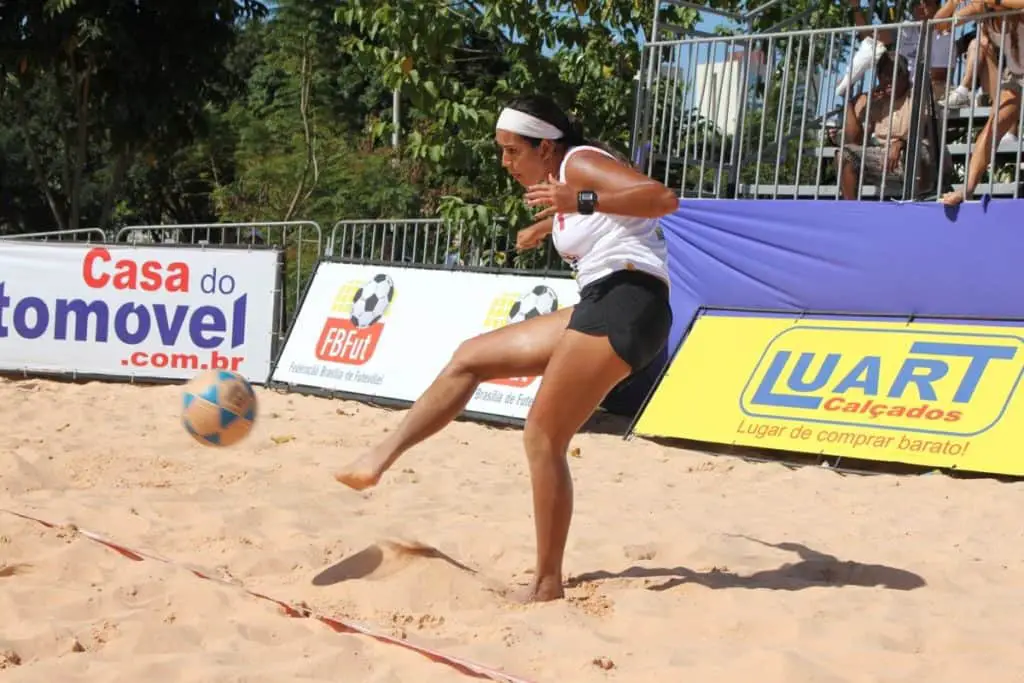
It was inevitable. The biggest sport in the world had to be roped into this. Footvolley is a mix of soccer and beach volleyball. In this volleyball variation, players are not allowed to use their hands, play with a soccer ball while following many of the rules of beach volleyball.
It may sound like a similar sport to our precedent volleyball variation, but in fact, Footvolley is very much its own different form of volleyball. This variation originated in Brazil in the 1960s. The rumor is that the game was conceived at a time when soccer was banned from many public beaches, while beach volleyball courts were still open. Soccer players had to innovate and adapt to this new court.
Variations and Differences
As I’ve said above, there are not that many rules and variations, but the ones that are made change the game drastically.
Here are the changes:
- Players are not allowed to use their arms and hands.
- The ball is replaced with one resembling a soccer ball.
- Players are allowed more than one contact with the ball in a row.
- Games are often only one set, first to 18 points.
- In competitions, games can be a best-of-3, where 15 points are needed to win a set.
| Court Size | Depending on the setting, the court will be: – 52.5 feet (16 meters) long by 26.2 feet (8 meters) wide. (same as beach volleyball) – 59 feet (18.29 meters) long by 29.5 feet (9 meters) wide. (same as indoor volleyball) |
| Number of players | 2 players per team. |
| Net Height | Men’s: The net should be set at 2.15 m (7 in). Women’s: The net should be set at 2 m (6 ft 6 in). |
The Ball
Footvolley uses a ball the same size as a volleyball with materials and panels closely resembling a soccer ball. The balls are made of hard synthetic leather. Official game balls such as the one below are all made using FIFA approved quality production and materials.
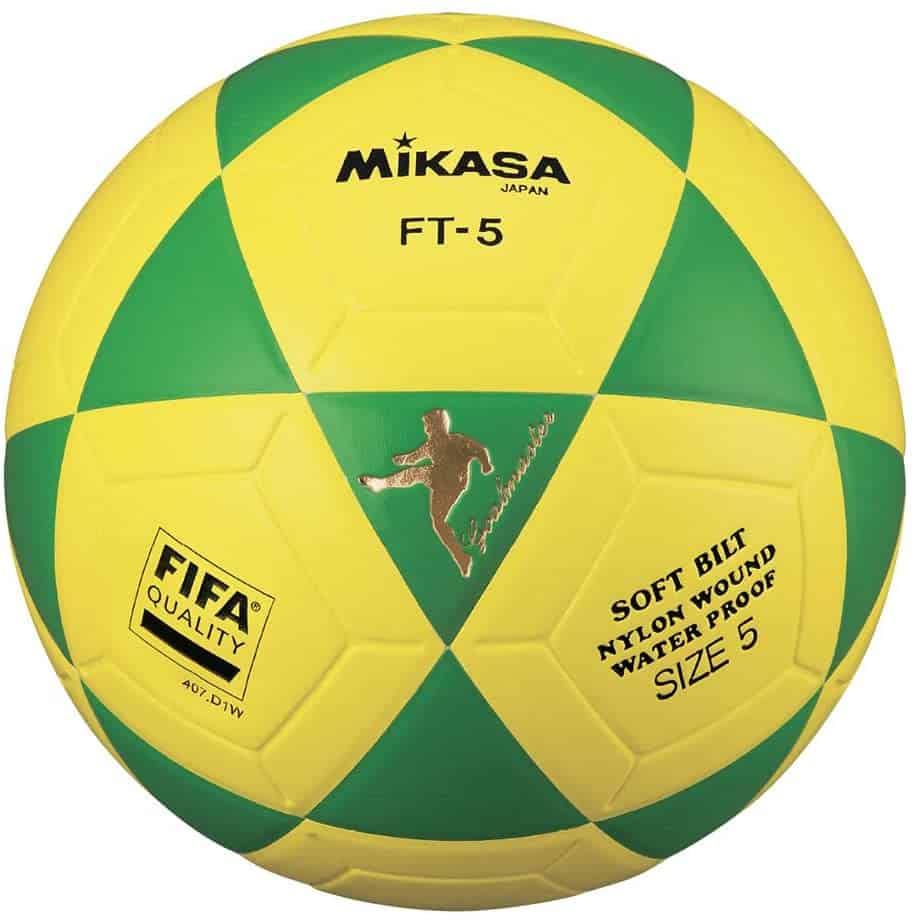
Competition
The sport has a pretty active scene in South America, Europe, and the US. In America, the Pro Footvolley Tour takes place every year since 2008. The event has received coverage from media platforms such as ESPN, AT&T Sports, Spectrum Sports, and many more.
Similarly, Europe has the European Footvolley League, and South America has many leagues, tournaments, and other competitions. Although not exclusive to South America, the Futevôlei (Footvolley) World Cup is the biggest event in the sport and it is almost always hosted by a South American country.
Popularity
Footvolley is growing in popularity, and it will keep growing. If you understand how big soccer is around the world, then it is no surprise that people will come to like this game. Soccer is the biggest sport in the world, without a doubt. By that fact, a variant like Footvolley is likely to be enticing for fans of both sports.
For many in South America, soccer is practically a religion, so it is understandable that Footvolley was originated from there. My understanding is that the game is so popular over there that when going to the beach, you cannot accurately predict which game you’ll see be played on the beach volleyball court.
5. Snow Volleyball
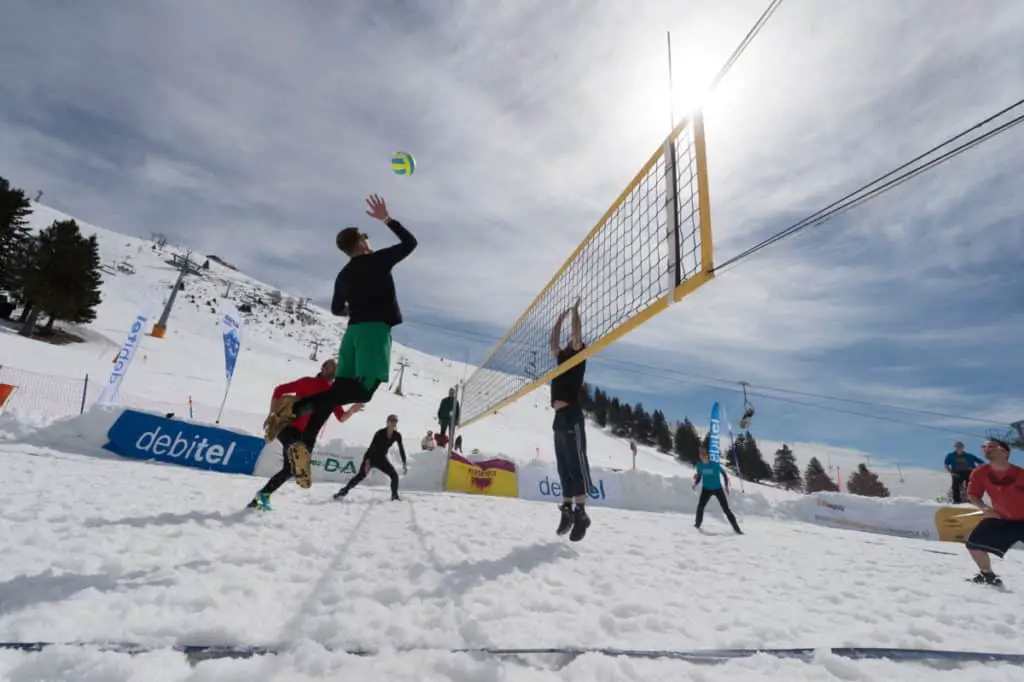
Overview
In fifth and final place, we have Snow Volleyball. Originating in Europe in the 1900s, Snow volleyball has since been growing in countries like Russia, Austria, and Switzerland. It’s only in 2008 that the sport gained greater popularity with the first Snow Volleyball Tour in Wagrain, Austria. Since then, the sport expanded competitions across European countries and culminated in 2019 with the inaugural FIVB Snow Volleyball World Tour. Although still in progress, there are plans and discussions promoting the addition of snow volleyball to future winter Olympic games.
This sport is the most recent addition to the line-up of volleyball variations under the FIVB. Much like indoor and beach volleyball, this format keeps similar core rules and gameplay with small changes.
Variations and Differences
Snow volleyball adopts many of the beach volleyball variations and adapts some of them to its new environment. Here are the differences with snow volleyball:
- The number of points needed to win changes from 25 to 15.
- Like indoor volleyball, the block touch will not count towards the 3 touches allowed.
- Open-hand tips or dinks are not allowed.
- Teams are allowed 1 substitute.
- The playing surface is all made out of snow.
One other difference, although there are no specific rules regarding clothing, many competitions have seen players wear thermal clothing and some type of cleats as footwear to provide grip on the snow.
| Court Size | 52.5 feet (16 meters) long by 26.2 feet (8 meters) wide. |
| Number of players | 3 players per team. |
| Net Height | Men’s: The net should be set at 2.43 m (7 ft 11 in) Women’s: The net should be set at 2.24 m (7 ft 4 in). |
The Ball
Just like in beach volleyball, snow volleyballs are spherical and made of a flexible and water-resistant material. The panels are adapted to have more padding and be softer to be more accommodating to the cold weather.
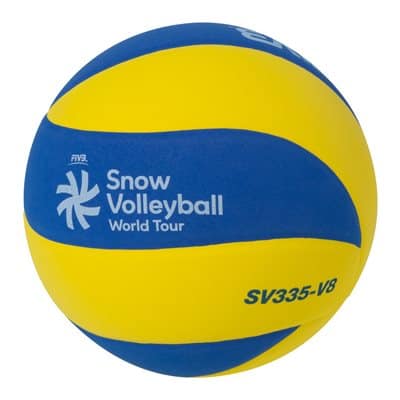
Competition
As of 2021, there are not many organized competitions of snow volleyball. The European Volleyball Confederation and the FIVB are continuously planning the expansion of the game and will be organizing more and more competitions as time goes on.
Popularity
Snow volleyball is very much one of the most recent additions to the world of volleyball. A lot is yet to be learned about the expansion and popularity of this sport, although it does seem to be a quite successful and known game in northern European countries. I personally will be keeping an eye out for this variant as I do live in a place that receives a lot of snow every year and it does seem to be a nice addition to the world of volleyball.

